Equipment
Sony FE 85mm f/1.4 GMaster Emergency Tear Down
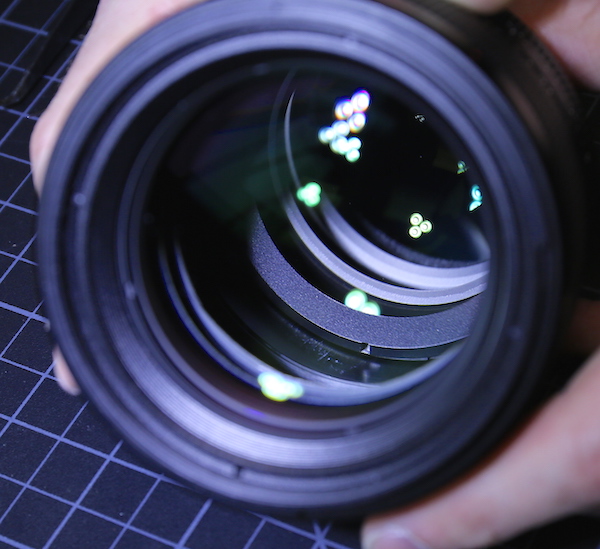

Credit: DC Super Friends Feature Vehicle Assortment 2012 Series 01
OK, I usually don’t respond to requests to disassemble things. I have a day job and the blog stuff is my hobby. But every so often the Bat Signal get’s raised over Gotham Internet and Aaron and I feel the need to fight the crime of massive overreaction and stomp out the flames of speculation-becoming-fact. I woke up yesterday to read that all Sony’s new 85mm f/1.4 G Master lenses made horrible grinding noises when focusing, were filled with metal shavings, had huge scrapes on their inner barrels, and caused cancer.
Before we get to myth busting, a couple of facts that I’ve gleaned from simply examining and testing 40+ copies of the 85mm f/1.4 GMaster.
- The Piezo (or SSM if you prefer) ring-linear drive does make noise. It’s noticeable. Every copy I’ve tried does to some degree, although some are louder than others. HOWEVER, if the camera is put in video mode the AF slows down and the noise is markedly reduced. So photo mode fast and noisy, video mode slower and quiet. That’s logical.
- Every 85mm wide-aperture lens I’ve ever looked in has some dust inside, NIB and no matter the brand. It’s partly because this type of lens has a front group that magnifies the interior. If yours doesn’t have dust in it then you don’t have a bright enough light to fuel your dust paranoia properly.
- Just over half of the 85mm f/1.4 G Master lenses I’ve looked at have some marks on the inner focusing barrel that look like either scrapes or lubricant. These don’t make any more or less noise than ones without marks. Also, a fair number have marks on only the lower part of the barrel. These are no noisier over the marked part than over the unmarked part. In other words, I didn’t find any association between barrel marks and noise.
So with all this in mind, Aaron and I put on our capes, grabbed our utility belts, went down to the Lens Cave and got to work. We picked a copy that had the typical ‘scrape’ marks that everyone is upset about.

Lensrentals.com, 2016

Lensrentals.com, 2016
Before we start let me mention that this is a rather urgent tear-down of a lens we had to get back in stock, so we didn’t do quite as much exploring as we sometimes do. Still, I think you’ll find it interesting.
So Let’s Look Inside
The rear light baffle comes off with three screws. Yes, I’m snarky for putting up this unnecessary picture.
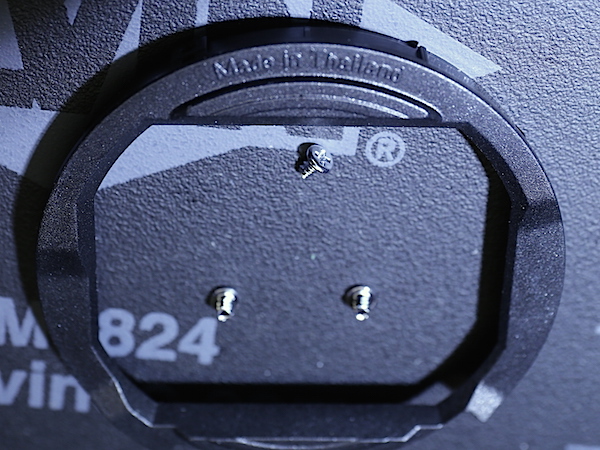
Lensrentals.com, 2016
Next, the rear bayonet is removed in the usual fashion, exposing the rear of the lens. We noted the PCB is different than we’ve seen in other Sony FE lenses; It’s smaller and screw mounted to the rear, rather than with rubber bumpers like the others we’ve opened. There are also silver shims or spacers on each side of the lens, which we assume allow a tilt adjustment (you can see there are two on the left, one on the right).

Lensrentals.com, 2016
Once the PCB is removed, taking out a few screws let us remove the rear barrel.
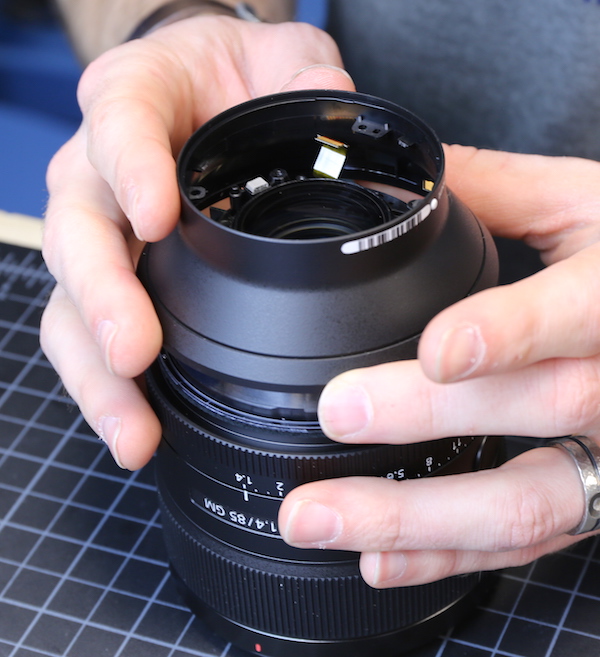
Lensrentals.com, 2016
The inner rear barrel is now exposed. There are two (one shows in the pictures) long copper ground leads that go back up to the bayonet mount, and several flex connectors that went up to the main PCB, but not much else of interest showing at this point.
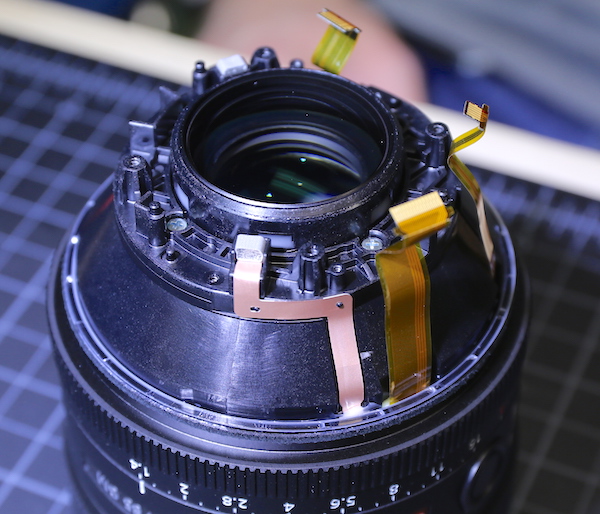
Lensrentals.com, 2016
The aperture ring slides off now. It has a nice mechanical feel and you can see the usual click ball bearing inside, but it controls the aperture electronically.
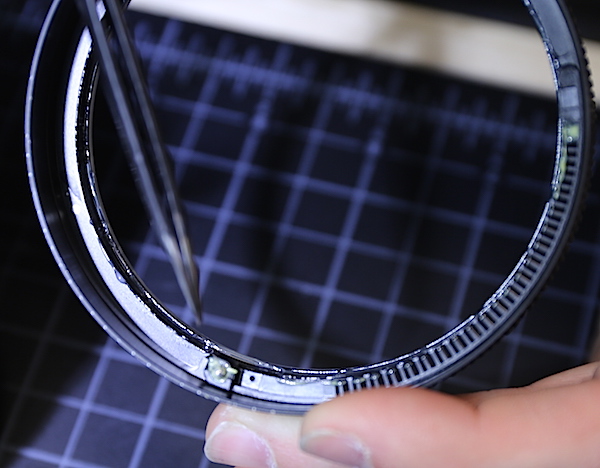
Lensrentals.com, 2016
On the inner barrel is a wedge (forceps point to it) that moves the ball bearing in and out of ‘click’ position so that you can declick the aperture when you want. You can see the little silver lever right above the ‘click on-off’ switch that moves this when you flip the switch.
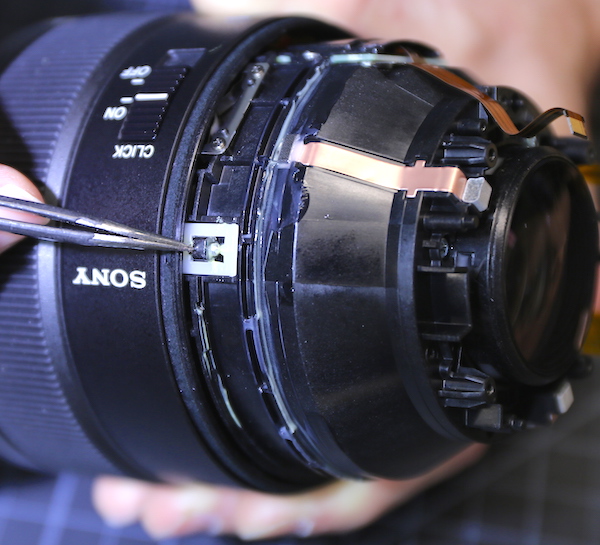
Lensrentals.com, 2016
On the other side is the aperture position sensor that actually tells the camera what position the aperture ring is set to.
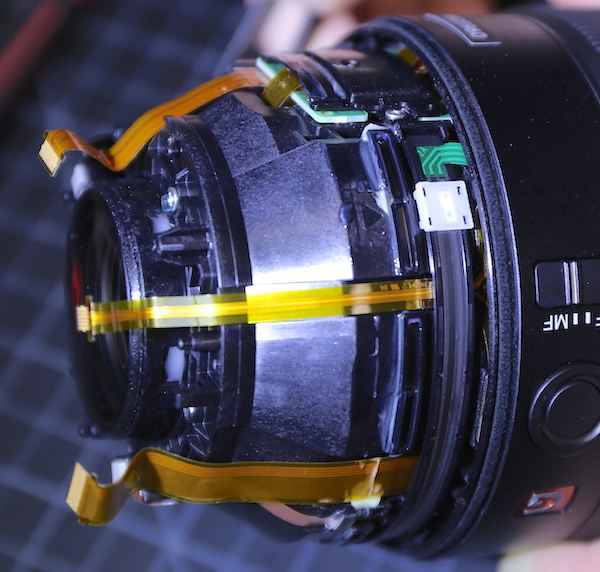
Lensrentals.com, 2016
You might have noticed a black plastic cover over a second circuit board in the image above. Removing the cover shows us another circuit board tucked down around the barrel which caused Aaron to have some Nikon disassembly flashbacks.
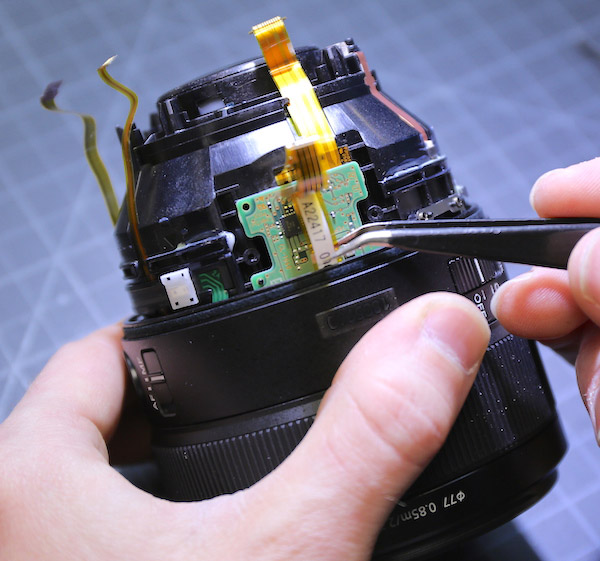
Lensrentals.com, 2016
Luckily it wasn’t that bad; there were not a bunch of soldered wires going to the second board, just flexes.
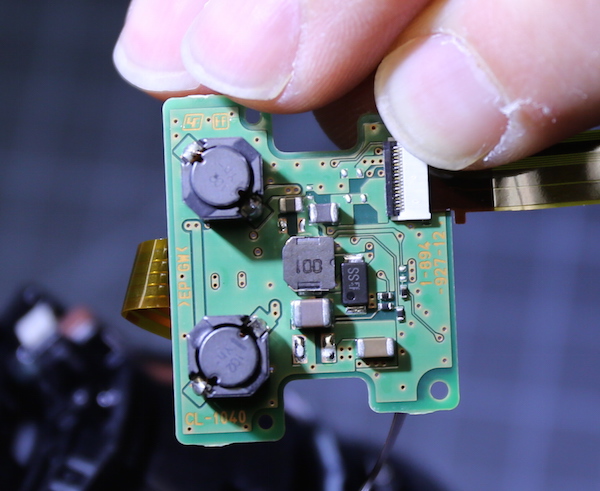
Lensrentals.com, 2016
And once all of that stuff had been disconnected we could take out a few more screws and remove the inner rear barrel.
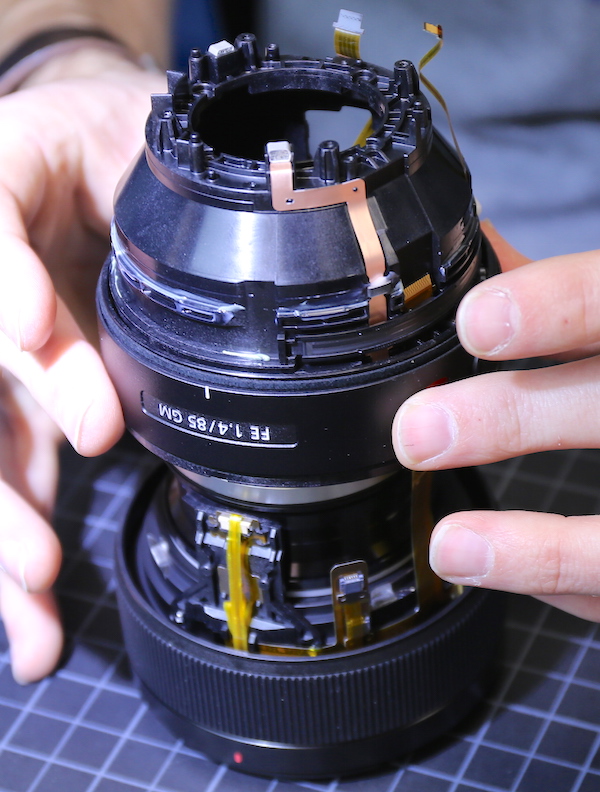
Lensrentals.com, 2016
This gives us a good look at the SSM (aka ring-piezo) motor. This is smaller than the ring USM motors we’re used to seeing in other lenses, but otherwise very similar.
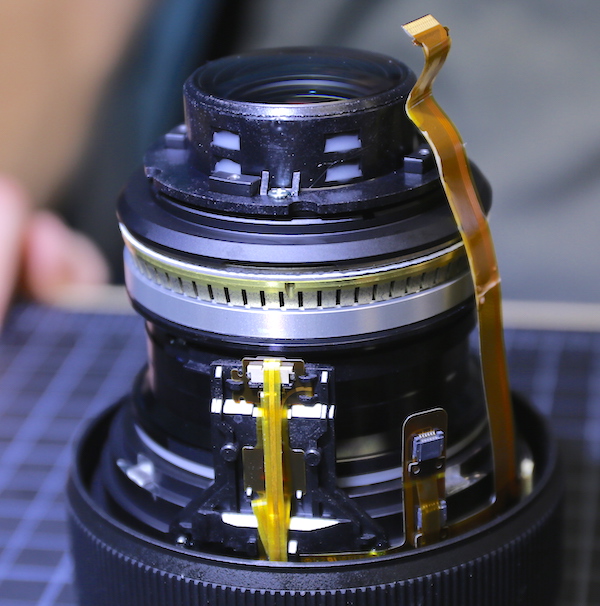
Lensrentals.com, 2016
While we could have taken the rear group off now (you can see one of its mounting screws in the image above) it was obviously not going to get us where we wanted to be, so we turned the lens over and spannered off the front makeup ring.

Lensrentals.com, 2016
When it was removed we saw a nice, thick, rubber sealing ring around the front element. This is actually light blue in color in room light, but under the tungsten work lights, it takes on a rather cool purple color.
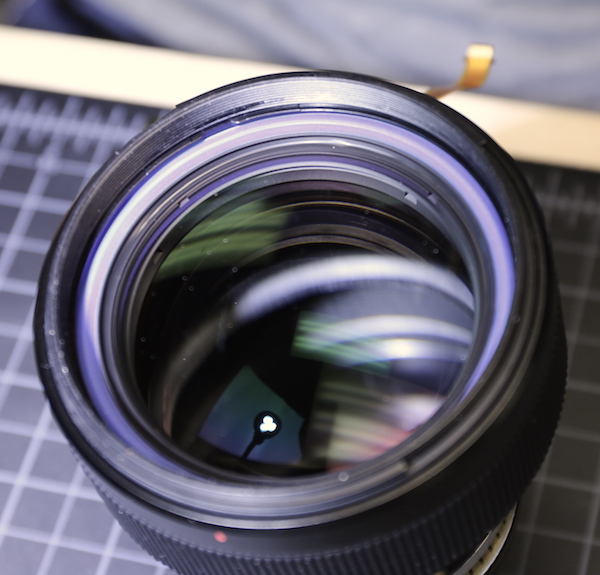
Lensrentals.com, 2016
Peeling the sealing ring up showed us three screws that let us remove the filter ring. This is a good thing, meaning broken filter rings should be an easy, reasonable cost replacement. Should be.
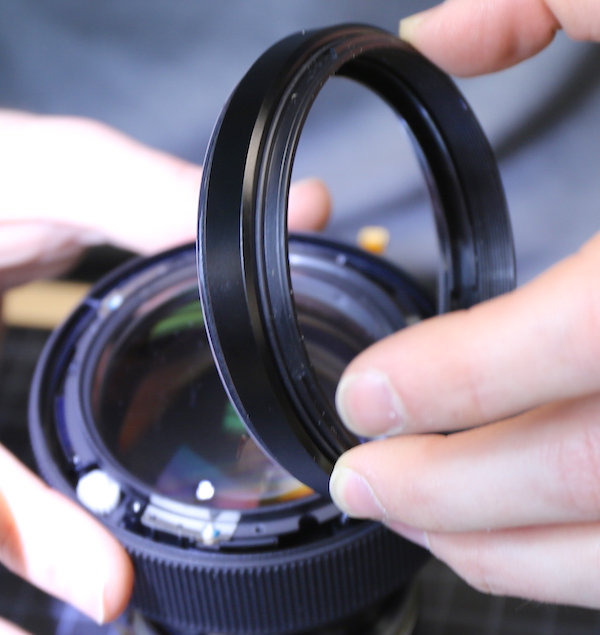
Lensrentals.com, 2016
With filter ring off we can look down into the focus ring. This lens is ‘focus-by-wire’; there’s no mechanical linkage between the ring and the focusing element. But there is a gear in here that is turned when you turn the ring. A couple of people have said manual focus feels rough but autofocus is smooth. This gear is probably the culprit in those cases. It just turns an electrical actuator or position sensor, but it is a mechanical gear, so if it’s damaged or gets a piece of grit in it, it would make the focusing ring feel rough.
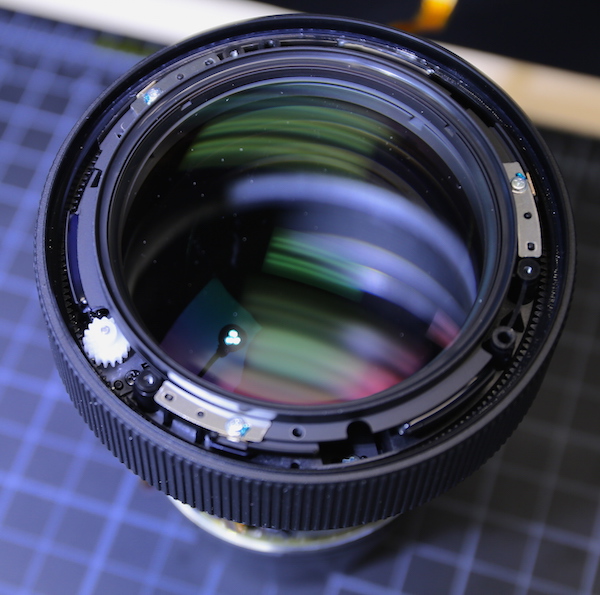
Lensrentals.com, 2016
This should come later in the disassembly, but here’s an image of the underside of the gear, showing you it doesn’t move any mechanical parts, it just drives an electric actuator. If the gear jammed up entirely the lens would still autofocus just fine.

Lensrentals.com, 2016
With the filter ring is off, we can lift the focus ring right off of the lens. You can see the gear teeth inside the ring that turn the white position sensing gear we showed you in the previous picture.
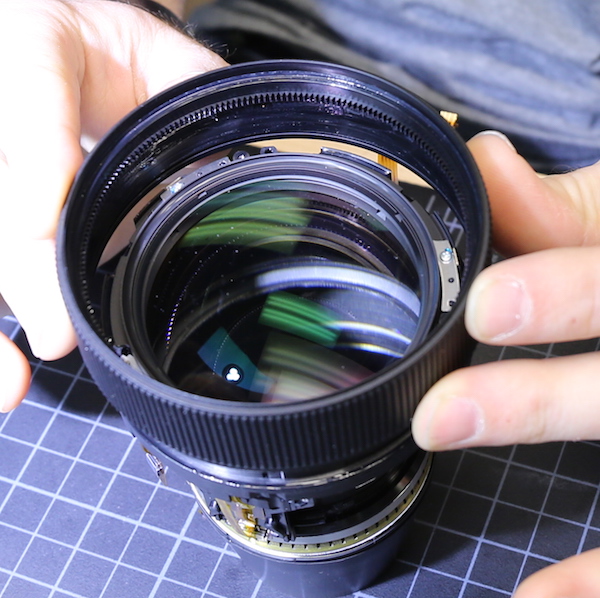
Lensrentals.com, 2016
Now we’re making some progress. All of the external barrels are removed and the core of the lens is exposed. Just because someone will ask, all of these barrels are heavy-duty polycarbonate. You heavy-metal fans will be disappointed, but it’s really solidly assembled. The inner barrels you see below are plastic, too.
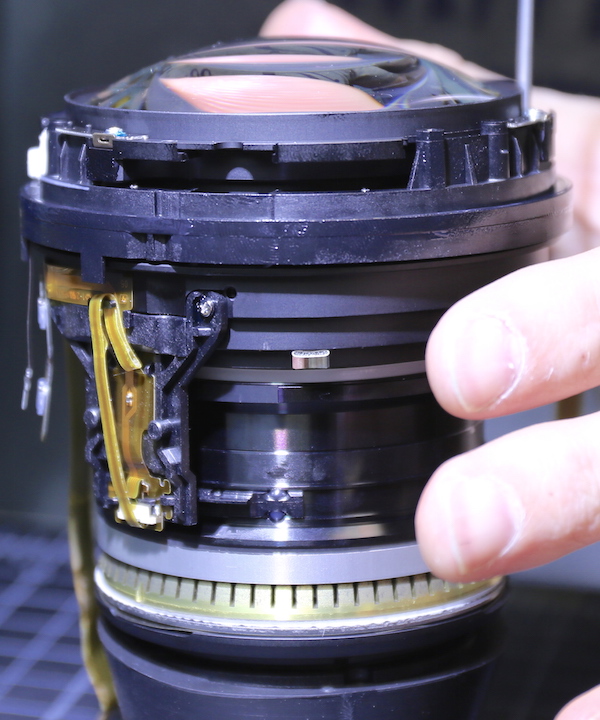
Lensrentals.com, 2016
Looking for optical adjustments isn’t the primary purpose of this teardown, but I’ll point out that the front group also has a set of shims. There is yet another set at a different level.

Lensrentals.com, 2016
In another nice touch, we can remove the front group at a slightly lower level than the shims, so we don’t have to disturb them.
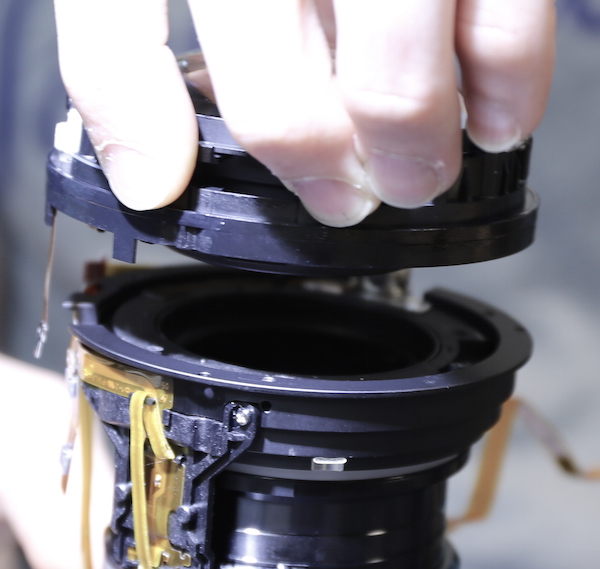
Lensrentals.com, 2016
Group 1 is a big group, the entire front portion of the lens. We could have separated this further, but there was no point in doing so.
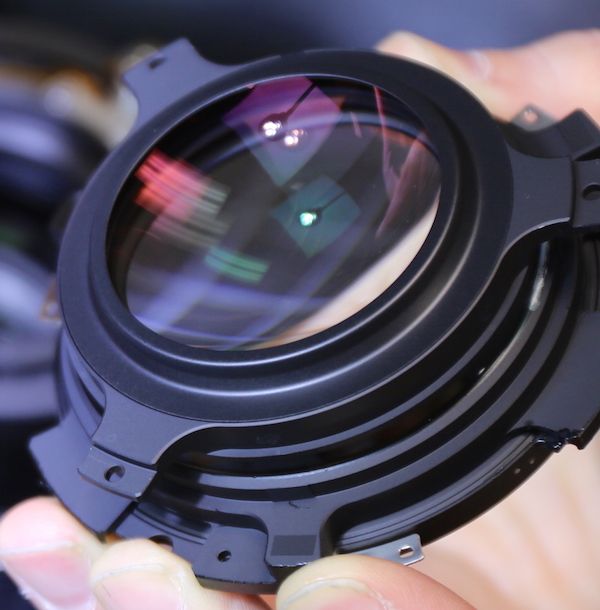
Lensrentals.com, 2016
The aperture assembly just lifts out now. By the way, this lens has a lovely, very round, aperture. But you can see that without me showing you, it’s readily apparent looking through the lens.
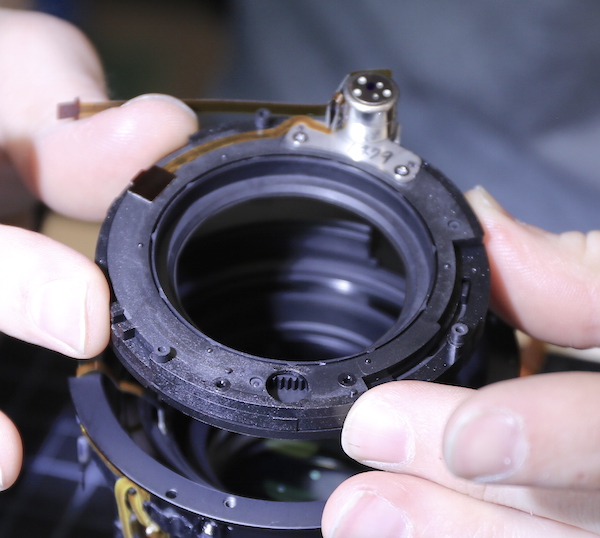
Lensrentals.com, 2016
Now, after all of this, we can finally get to see those ‘scratches’ in the inner barrel. They didn’t visualize that well when we began, it’s hard to take a good image through that big front element. Now you can see them all around the inner focusing barrel; Aaron is pointing a Q-tip towards some of the worst ones.
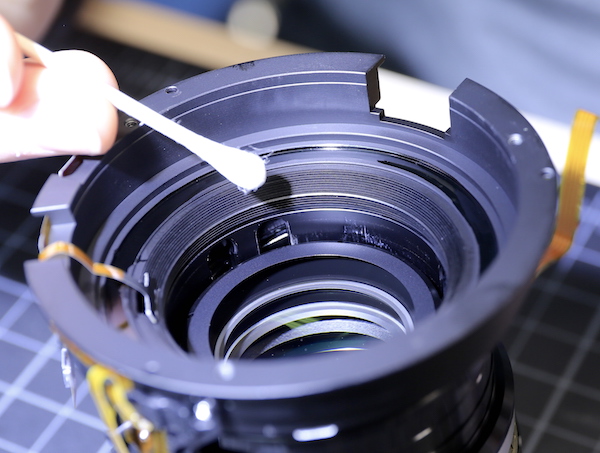
Lensrentals.com, 2016
A quick swipe with a Kim-wipe takes them right off. Although they did look a lot like scratches it was just lubricant.
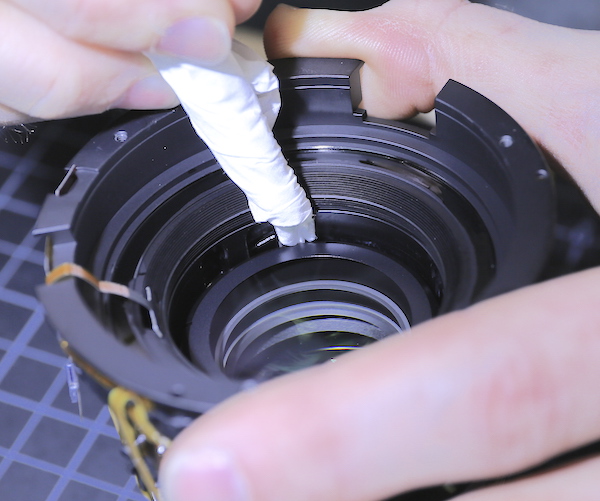
Lensrentals.com, 2016
If you are like me, you’re just dying to know how that ring SSM motor is also called a linear focusing system. I would love to take the motor apart and show you, but that’s going to have to wait. We weren’t ready to disassemble a ring SSM because we weren’t certain we’d be able to restack it properly and this lens was needed. To be honest we shouldn’t have disassembled this lens at all, but, well, people were wrong on the internet and we couldn’t leave that alone.
I was able to get you a little picture down along the focusing group, though, showing you that it travels in straight-line grooves up and down; it doesn’t rotate in a helicoid assembly to move forward. I’ll add that while we were poking around we checked and the focusing group is surrounded by plastic. It’s not going to scrape the inner barrel.
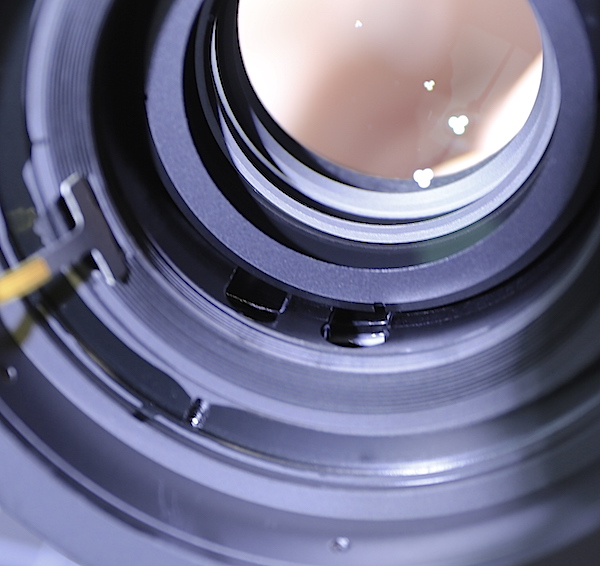
Lensrentals.com, 2016
Before I summarize, the usual: yes, we put it back together. Yes, we tested it mechanically, electrically and optically and it works perfectly. And, yes, it’s back in the rental fleet. I’m also certain someone will want to know this, too: No, we are not opening every copy up and cleaning out any visible lubricant. We have work to do fixing broken stuff, righting wrongs, and making the internet a safer place to live.
So, What Did We Learn Today?
Let’s start with what I know.
Focusing Noise
The Sony FE 85mm f/1.4 GM lens has a focusing system that makes some noise. It sounds a little like metal scraping or a linear piezo motor even though it’s an SSM motor. It’s much quieter in video AF mode. Nearly silent. But focuses slower.
It should sound and focus the same in manual or auto modes. If it doesn’t there may be a problem (probably some grit or dust) around the focus actuator gear (yes, I made that name up, but you know what I mean).
Barrel Markings
About half of these lenses have some visible lubricant on the inner focusing barrel that looks like scratches but isn’t. It is not scratches. Yes, I know the focusing sounds like scratches. Yes, I know the lubricant looks like scratches. And yes, I am certain that some person somewhere is going to have a lens with real scratches on the inner focusing barrel. Because given enough lenses, there will be one with anything.
Now let’s move on to what I think, but don’t know for certain.
It may be that over some time every single one of these lenses will have some lubricant show up on the inner barrel. Or it may smooth out over time to a beautiful, lustrous sheen that makes your bokeh glow like a sunrise in Yosemite. Sony may change assembly procedures or lubricant in future batches and it won’t be there anymore. But for right now, if you buy this lens you may see some lubricant in the inner barrel that looks like scratches.
Some people are absolutely certain they’ve seen metal shavings in their lens. That’s possible (see above comment about scratches) but I’m pretty sure that means someone added some metal shavings during assembly. There’s not much metal inside this lens, and what there is is surrounded by plastic parts that I can’t imagine are shaving metal. I am certain that everyone who looks carefully with a bright light is going to see some dust, though. It’s a wide aperture 85mm lens. Those all basically have dust you can see if you look carefully enough right out of the box. If you clean it all out, they’ll have some more in 3 days. Cope.
Does this mean the lens is problem free? Absolutely not. I don’t know if that lubricant might affect images (I doubt it, but it’s possible it could cause some glare when focusing close up). I suspect in a few cases lube will have gotten onto a lens element and caused a streak and that is much more likely to affect images. If you see streaks on a lens element than I’d return yours or send it in to be cleaned.
It might be that 6 months from now we find out that all of these lenses should be absolutely silent when focusing. I’ve looked at lots of them, but they obviously were all early production run lenses. There may be a fix Sony comes up with. I suspect, though, that a firmware fix will be slowing down AF to make it quieter.
In the meantime, optically this is a superb lens and a lot of people are making great images with it.
I’ll just mention that some of you are going to think I’m not being hard enough on Sony over this. You may be right, like everyone I have my own likes and dislikes. Sony is doing some new, really radical things with lenses (OK, probably not Sony, but people Sony is hiring and giving green lights to). I’m completely aware that when you do a bunch of radical new things some are going to have problems. It’s inevitable. But some are going to be great. That’s how progress happens. I’m all for progress.
And let’s be honest, guys (because us early-adopters are 99% guys). When we preorder something that’s never been seen before, we’re signing on for this kind of stuff. The logical people don’t buy anything until it’s been out a few months. But where’s the fun in that?
Roger Cicala and Aaron Closz
Lensrentals.com
April, 2016
Author: Roger Cicala
I’m Roger and I am the founder of Lensrentals.com. Hailed as one of the optic nerds here, I enjoy shooting collimated light through 30X microscope objectives in my spare time. When I do take real pictures I like using something different: a Medium format, or Pentax K1, or a Sony RX1R.
-
Matias Brelaz
